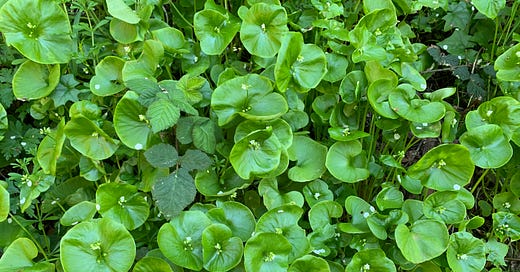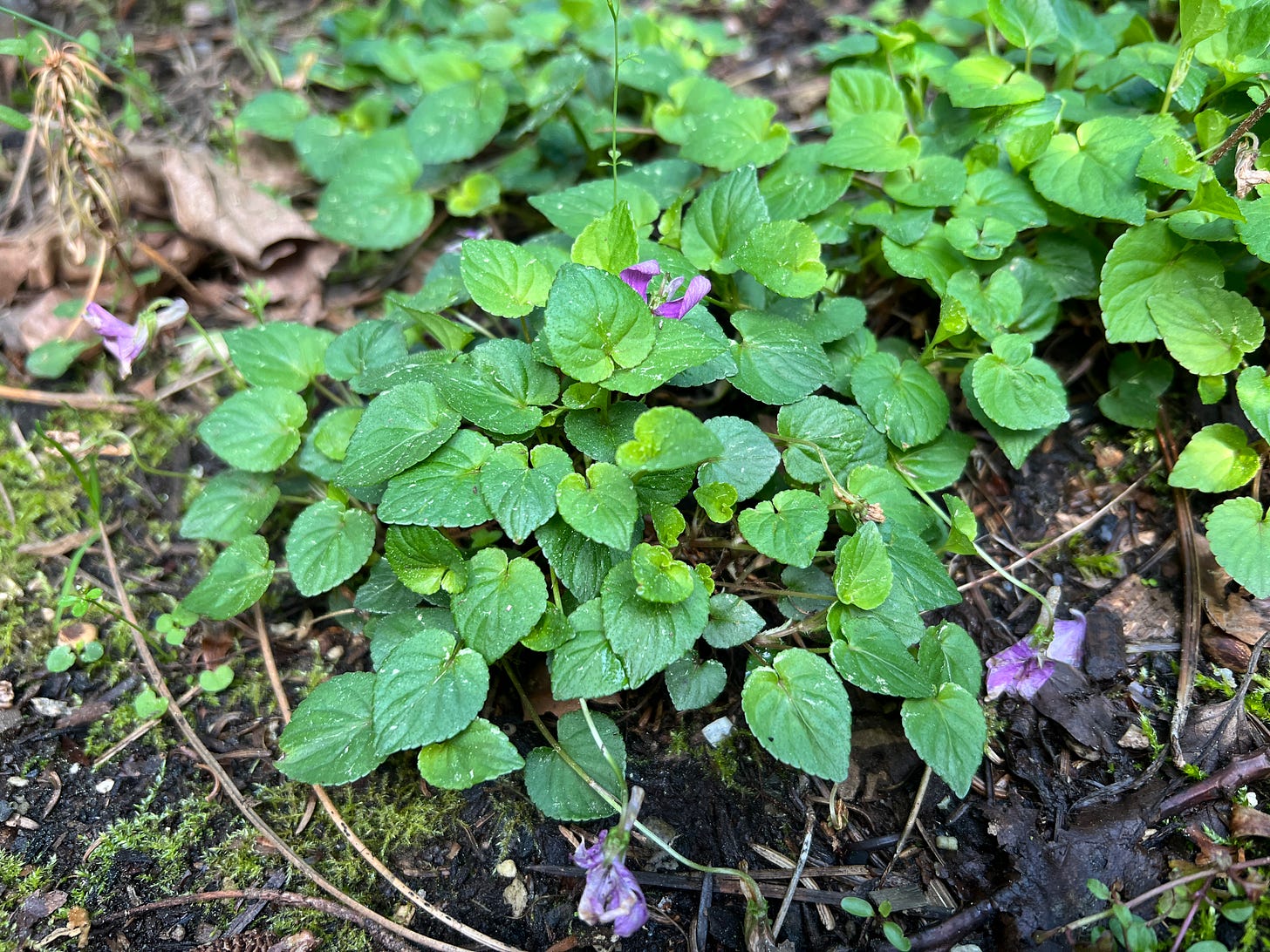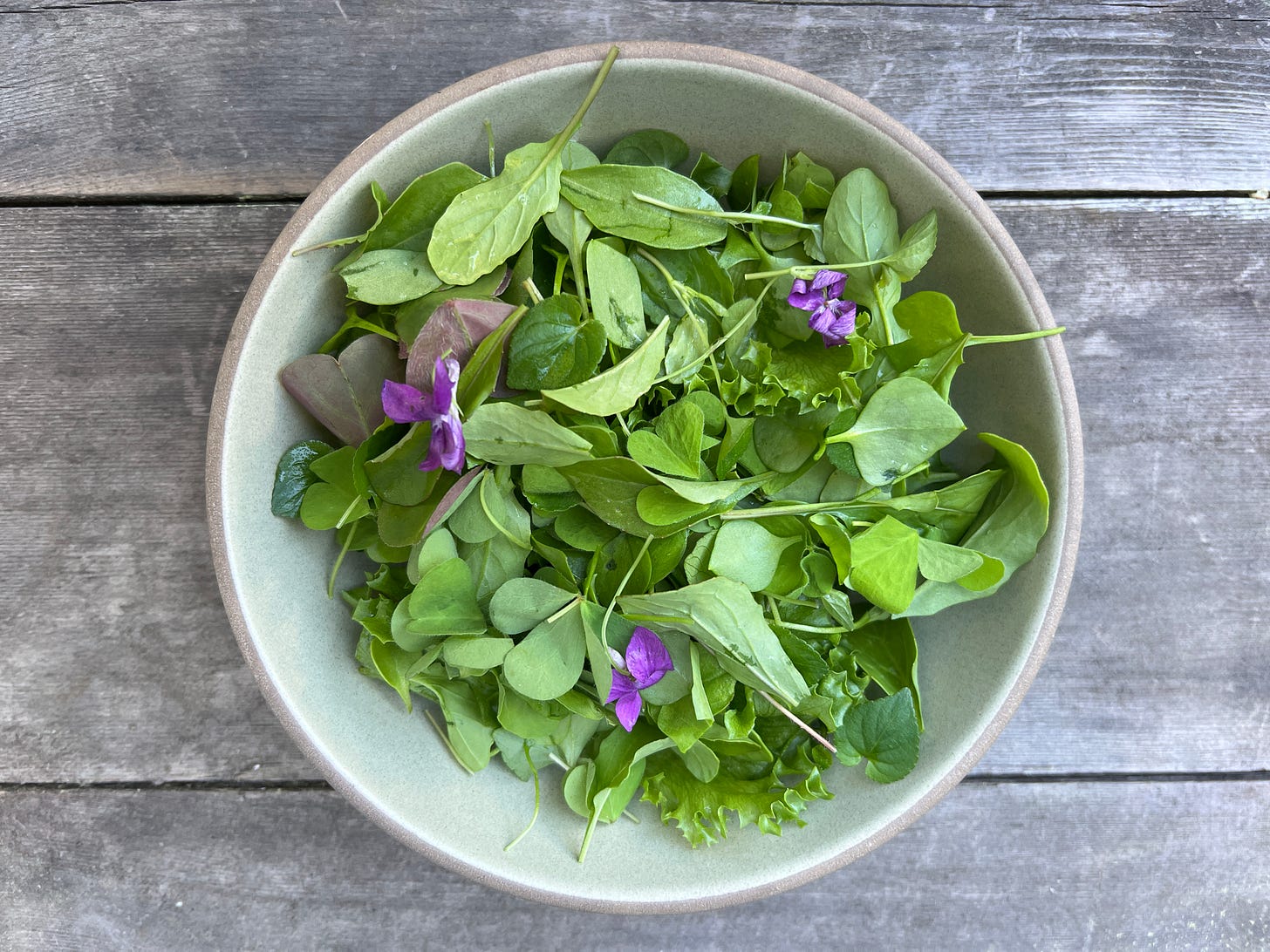Planting an ever-bearing salad in the yard
Dreaming of spring salads made with home-foraged greens
Ever since I killed off our front lawn, I've been trying to cultivate an ever-bearing salad.
When I sheet-mulched over my lawn three summers ago, I had very little knowledge of native plants, perennials, or self-seeding annuals. What I did have was a vision of a shady section of the yard covered with the kinds of salad greens that people usually forage. It would be a green carpet, I vision-boarded, ruffling in the breeze, and I’d plod out there with snippers at 6pm to snip off tender leaves for the night's dinner.
With that in mind, I ordered starter salad crops: a few trays of wood sorrel starts and a packet of miner's lettuce1 seeds. I nestled sorrel plugs into the woodchips, then scattered the entire packet of seeds overtop.
Reader, the me of three years ago was so innocent. Even though miner's leaf seeds are the size of an ant's nose, the seeds had no way to pinball down through 6 inches of coarse woodchips to germinate in the soil, then snake their tender stems back up through this sharp-edged maze to catch the light. And Portland's 117-degree heatwave immediately baked away the sorrel.
So I did it again. After two more years of replanting and reseeding, small patches of Suksdorf's woodsorrel and the larger-leafed Oregon woodsorrel circle our blueberry bushes. Despite the fact that miner's lettuce is like arugula — a self-seeder that claims its turf and refuses to decamp — our wood chips haven't broken down enough yet to welcome it in our lawn. This February, I followed a nursery owner's suggested and scattered seeds over the soil in a wine-barrel planter.
My hope this time around was to begin harvesting these perennial-ish greens from early April until the spinach and lettuces started producing in the raised beds. I even identified a third salad green to add to the mix: the purple dog violets that have spread across the back yard, a gift from one of the house's former owners. (They're probably a naturalized European variety of these scentless edible flowers, not Oregon's own Viola adunca.)
I have been watching and waiting all spring, but May has started, and once again, I realized I haven’t mastered the most critical gardening skill: getting the timing right. Spring after spring, I have learned, my garden crops thwart my scheduling plans with their own selfish demands, waiting for the heat and light from the sun, the warmth of the soil, a thousand chemical signals to take off. The neck-jerking temperature swings that climate change has introduced haven't made it easier to intuit when and where to plant. It sometimes feels as I am trying to clap along to a polyrhythmic song, always hitting the beat wrong.
So the violet flowers are almost gone for the year, while my miner’s lettuce pot is still a thicket of seedlings. Normally, miner's lettuce is one the year’s first greens to flourish in March. It is stupidly adorable and impossible to misidentify, with its satellite-dish leaves and floral antennae. What I realized this year was that for my miner’s lettuce to grow into its distinctive shape by April, it has to have sprouted and died and self-seeded and overwintered over the course of the previous year.
On the eve of our first May heatwave this week, before the last violet flower withered away, I gathered the first and last perennial salad of 2024: delicate and immature sprigs of miner's lettuce, a clump of wood sorrel's origami-pleated leaves,2 tiny heart-shaped violet leaves and a few flowers. I added some of the year's first baby arugula — I planted an entire garden bed full of it this year, which I will shear down in a couple of weeks to replace with summer crops.
The tiny leaves of my perennial salad were painstaking to clean, but they did look Instagrammable, so that's something, I suppose. And because the fashion parade at this week’s Met Gala reminded me that everything is better when it's 10% more ridiculous, I coated the salad with a dressing made with neighborhood honey and quince vinegar I cultured from my friends' fruit.
Even with the lemony bite of the wood sorrel, the flavor of this salad was lovely but too fragile. It reminded me of a restaurant owner in San Francisco who once told me she grew her own salads because the spring mix most farmers sold was picked too early for the lettuces to take on any character. You're not eating baby greens, she said. You're eating the equivalent of milk-fed veal.
As a proof of concept, however, the cupful of leaves I harvested felt like a triumph.
A triumph enough, at least, to think bigger. I just received in the mail a packet of seeds that I'm going to try planting alongside the wood sorrel this September so it can overwinter: Mache, which is also called “corn salad” because it loves to grow in Europe’s grain fields in early spring and after the harvest. Perhaps I can get mache to become a perennial guest in my North Portland lawn, too.
Next year I'll have the ever-bearing salad of my delusions vision. I just know it.
****
Other Delicious Things to Find Right Now
Spruce tips are hitting their peak in Western Oregon’s shadier or slightly higher-altitude areas (I just missed my chance with the tree on our block)
Grape vines are just about to explode in this weeks’ heat wave; I make a batch of dolmas from the supple, lighter-green leaves every year
Nodding onions and field garlic are everywhere
In Northern California, they're reclaiming rooreh as the Ohlone name for miner's lettuce, Claytonia perfoliata. I can't find the name in Chinook or Kalapuyan languages, though its relative, Claytonia siberica, is better documented. If you know, let me know!
Wood sorrel does contain a lot of oxalic acid, I know, but eating a handful of the greens here and there isn’t going to cause any problems.










Oh, hey: If you have any other suggestions for perennial or self-seeding salad greens that do well in sunny yards, let me know?
This is cool Jonathan, and inspiring! I think we could do this with our front yard after sheet mulching!